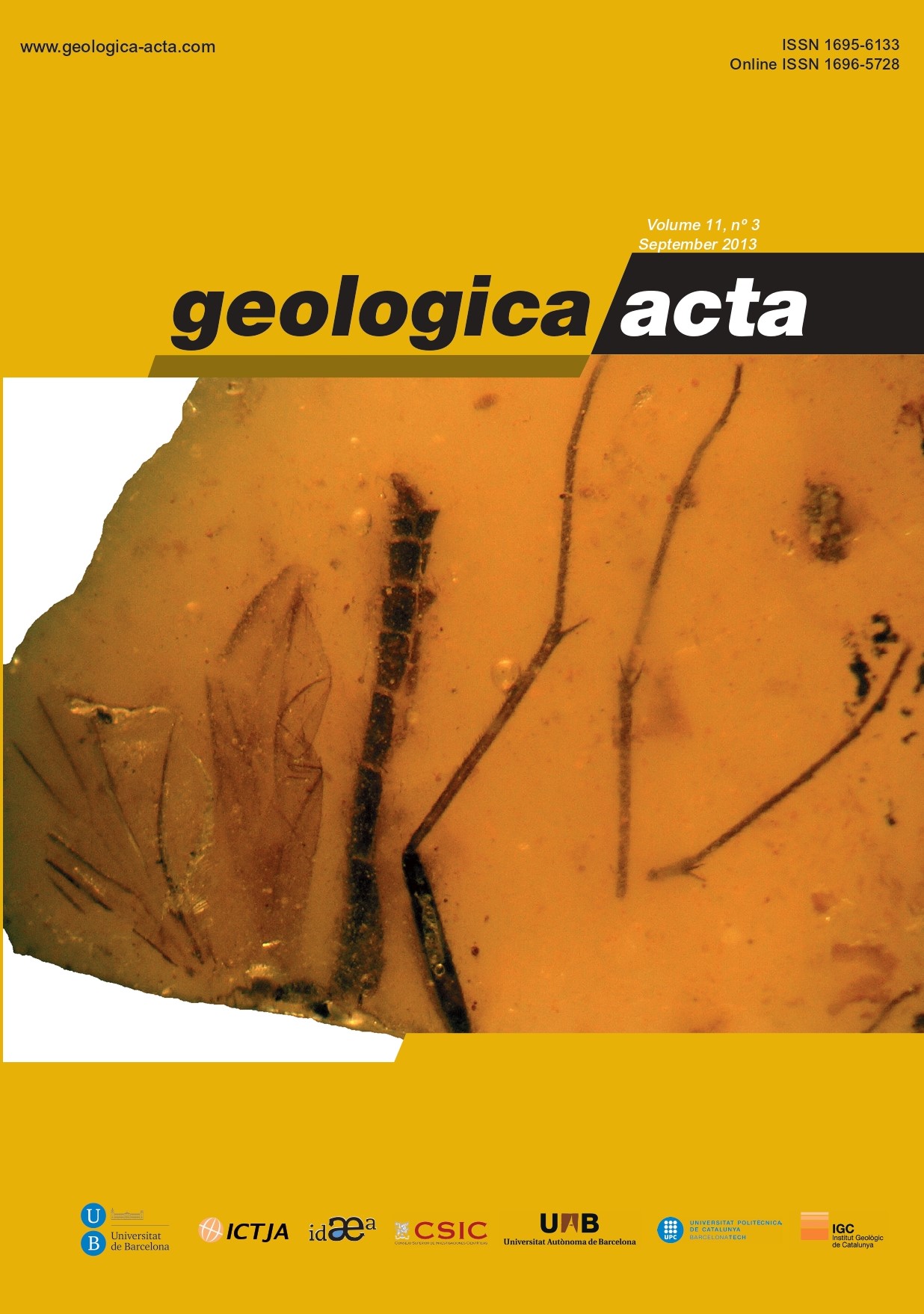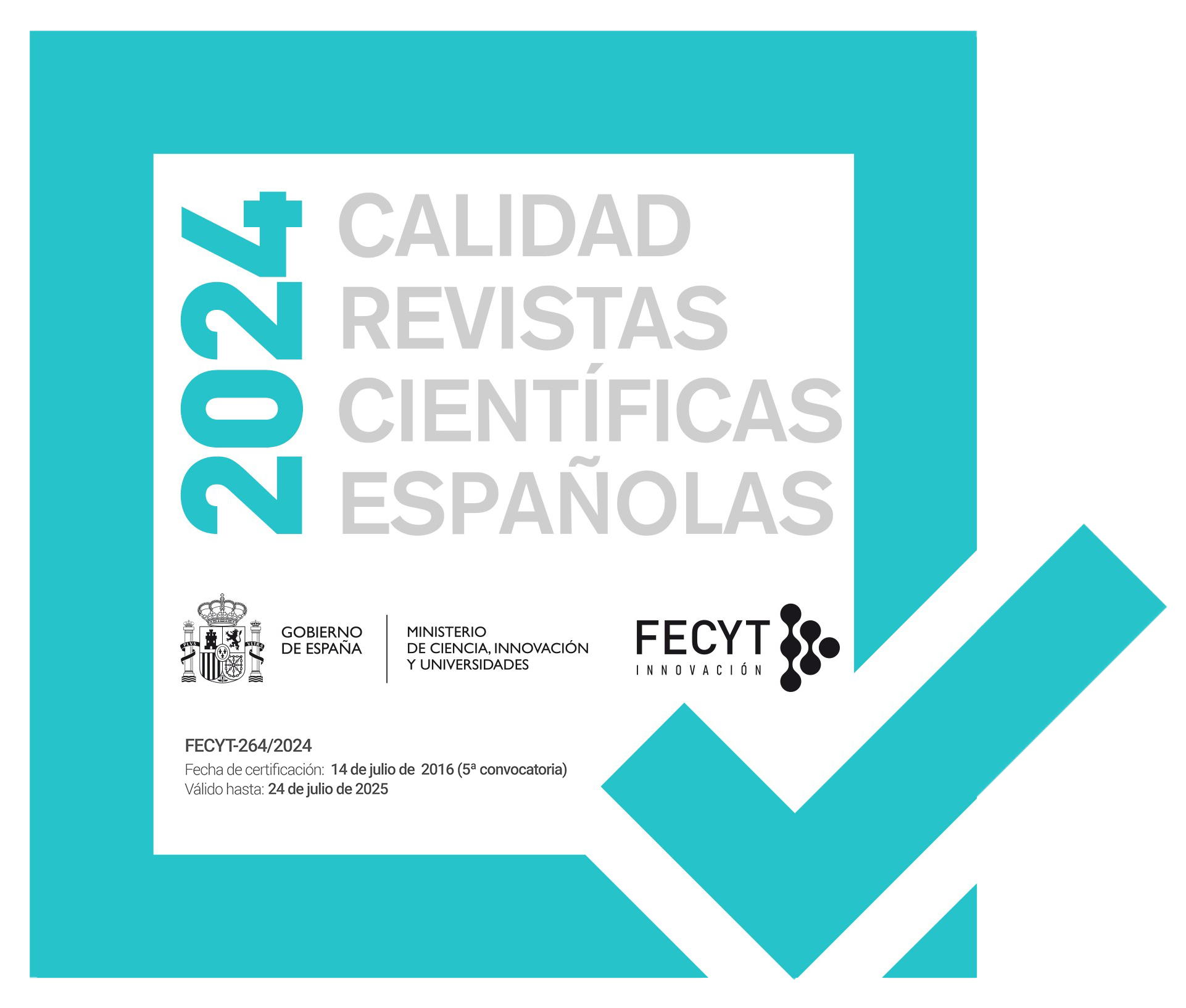Multidetachment analogue models of fold reactivation in transpression: The NW Persian Gulf
DOI:
https://doi.org/10.1344/105.000001870Keywords:
Analogue modelling, Reactivation, Multi detachment, Compression, Transpression, Persian GulfAbstract
Two deformation events have been documented in the NW Persian Gulf during the Late Cretaceous and the Late Cenozoic. The most distinctive feature in this part of the Persian Gulf is the reactivation of the Late Cretaceous NNE-SSW Arabian trending folds by NE-SW shortening during the Late Cenozoic Zagros orogeny. In general, if a set of folds with horizontal axes is shortened roughly parallel to its fold axis, a dome-basin fold interference pattern is produced. In the NW Persian Gulf, reactivation of some old folds occurred instead of a fold interference pattern. Reactivation may be influenced by the following factors: i) the presence of incompetent layers (i.e. evaporites), ii) a variable overburden, iii) basement faults, and iv) obliquity between the younger deformation shortening axis and fold axis. It is this last factor that we investigated by means of analogue modelling. The experimental apparatus is similar to that commonly used for experiments with brittle-ductile systems at the Laboratory of Experimental Tectonics of Géosciences Rennes. The model consisted of an alternation of ductile and brittle horizontal layers with a stratigraphy similar to the one found in the NW Persian Gulf. The model was deformed by two deformation events with an angle α between the two directions of shortening. After deformation, the resulting structure resembled a fold facing the static wall with internal thrust faults and detachment faults arranged into a geometry similar to a fish tail. In the second shortening event, the fold was reactivated without formation of an interference pattern. Moreover, the displacement on both the reactivated and newly formed faults varied between almost pure thrust faults for low α and oblique thrust faults with a strike-slip component for high α. The models suggest that the presence of incompetent layers plays an important role in fold reactivation and confirm that basement faults are not necessary.
References
Abdollahie Fard, I., Braathen, A., Mokhtari, M., Alavi, A. 2006. Interaction of the Zagros Fold-Thrust Belt and the Arabiantype, deep-seated folds in the Abadan Plain and the Dezful Embayment, SW Iran. Petroleum Geoscience, 12, 347-362.
Alavi, M., 1994. Tectonics of the Zagros orogenic belt of Iran: new data and interpretations. Tectonophysics, 229, 211-238.
Allemand, P., Brun, J.-P., Davy, P., Van Den Driessche, J., 1989. Symétrie et asymétrie des rifts et mécanismes d’amincissement de la lithosphère. Bulletin de la Société Géologique de France, 3(V), 445-451.
Alsharhan, A.S., Nairn, A.E.M., 1997. Sedimentary Basins and Petroleum Geology of the Middle East. Amsterdam, Elsevier Science, 280pp.
Bahroudi, A., Talbot, C.J., 2003. The configuration of the basement beneath the Zagros Basin. Journal of Petroleum Geology, 26(3), 257-282.
Balé, P., 1986. Tectonique cadomienne en Bretagne nord. Interaction décrochement chevauchement: champs de déformation et modélisations expérimentales. Thèse de 3ème cycle. Université de Rennes 1, 361pp.
Ballard, J.F., 1989. Approche géologique et mécanique des décollements dans la croûte supérieure. Thèse de Doctorat. Université de Rennes 1, 301pp.
Barrier, L., Nalpas, T., Gapais, D., Proust, J.-N., Casas, A., Bourquin, S., 2002. Influence of syntectonic sedimentation on thrusts geometry. Field examples from the Iberian Chain (Spain) and analogue modeling. Sedimentary Geology, 146, 91-104.
Beydoun, Z.R., 1991. Arabian plate hydrocarbon geology and potential - a plate tectonic approach. American Association of Petroleum Geologists Studies in Geology, 33.
Brun, J.P., Nalpas, T., 1996. Graben inversion in nature and experiments. Tectonics, 15(2), 677-687.
Casas, A.M., Gapais, D., Nalpas, T., Besnard, K., Roman Berdiel, T., 2001. Analogue models of transpressive systems. Journal of Structural Geology, 23(5), 733-743.
Casciello, E., Vergés, J., Saura, E., Casini, G., Fernández, N., Blanc, E., Homke, S., Hunt, D.W., 2009. Fold patterns and multilayer rheology of the Lurestan Province, Zagros Simply Folded Belt (Iran). London, Journal of the Geological Society, 166, 947-959. DOI:10.1144/0016-76492008-138
Davy, P., Cobbold, P.R., 1991. Experiments on shortening of a 4-layer model of continental lithosphere. Tectonophysics, 188, 1-25.
Dewey, J.F., Holdswoth, R.E., Strachan, R.A. 1998. Transpression and transtension zones. London, Geological Society, 135 (Special Publications), 1-14.
Drozdzewski, G., 1979. Grundmuster der Falten – und Bruchstrukturenim Ruhrkarbon. Zeitschrift deutsche. Geologische Gesellscharft, 130, 51-67.
Dubois, A., Odonne, F., Massonnat, G., Lebourg, T., Fabre, R., 2002. Analogue modeling of fault reactivation: tectonic inversion and oblique remobilisation of grabens. Journal Structural Geology, 24, 1741-1752.
Edgell, H.S., 1991. Proterozoic salt basins of the Persian Gulf area and their role in hydrocarbon generation. Precambrian Research, 54, 1-4.
Edgell, H.S., 1996. Salt tectonism in the Persian Gulf Basin. In: Alsop, G.L., Blundell, D.J., Davison, I. (eds.). Salt Tectonics. London, Geological Society, 100 (Special Publications), 129-151.
Emami, H., Vergés, J., Nalpas, T., Gillespie, P., Sharp, J., Karpuz, R., Blanc, E.P., Goodarzi, M.G.H., 2010. Structure of the Mountain Front Flexure along the Anaran Anticline in the Pusht-E-Kuh Arc (NW Zagros, Iran): insights from sand box models. In: Leturmy, P., Robin, C. (eds.). Tectonic and Stratigraphic Evolution of Zagros and Makran during the Mesozoic–Cenozoic. London, Geological Society, 330 (Special Publications), 155-178. DOI: 10.1144/SP330.9 0305-8719/10/
Faccenna, C., Nalpas, T., Brun, J.P., Davy, P., 1995. The influence of preexisting thrust faults on normal fault geometry in nature and in experiments. Journal of Structural Geology, 17, 1139-1149.
Faugère, E., Brun, J.P., 1984. Modélisation expérimentale de la distension continentale. Comptes Rendus de l’Académie des Sciences, Série II, 299, 365-370.
Gestain, V., Nalpas, T., Rouby, D., Barrier, L., 2004. Rôle des niveaux incompétents syncinématiques sur l’évolution des structures chevauchantes. Bulletin de la Société Géologique de France, 175(4), 351-359.
Harding, T.P., 1985. Seismic characteristics and identification of negative flower structures, positive flower structures and positive structural inversion. American Association Petroleum Geology Bulletin, 69, 582-600.
Harrison, J.C., Bally, A.W., 1988. Cross sections of the Parry Islands fold belt on Melville Island. Canadian Petroleum Geology Bulletin, 36, 311-332.
Homke, S., Vergés, J., Garcés, M., Emami, H., Karpuz, R., 2004. Magnetostratigraphy of Miocenen-Pliocene Zagros foreland deposits in the front of the Push-e Kush Arc (Lurestan Province, Iran). Earth and Planetary Science Letters, 225, 397-410.
James, G.A., Wynd, J.G., 1965. Stratigraphic nomenclature of Iranian Oil Consortium Agreement Area. American Association Petroleum Geology Bulletin, 49, 2182-2245.
Krantz, R.W., 1991. Measurements of friction coefficients and cohesion for faulting and fault reactivation in laboratory models using sand and sand mixtures. Tectonophysics, 188, 203-207.
Koopman, A., Speksnijder, A., Horsfield, W.T., 1987. Sandbox model studies of inversion tectonics. Tectonophysics, 137, 379-388.
Letouzey, J., 1990. Fault reactivation, inversion and fold-thrust belt. In: Letouzey, J. (ed.). Petroleum and tectonic in Mobile belts. Paris, Technip, 101-128.
Malavielle, J., 1984. Modélisation expérimentale des chevauchements imbriqués: application aux chaînes de montagnes. Bulletin de la Société Géologique de France, XXVI(1), 129-138.
Mescua, J.F., Giambiagi, L.B., 2012. Fault inversion vs. new
thrust generation: A case study in the Malargüe fold-andthrust belt, Andes of Argentina. Journal of Structural Geology,
, 51-63. DOI: 10.1016/j.jsg.2011.11.011
Nalpas, T., le Douaran, S., Brun, J.P., Unternehr, P., Richert, J.P., 1995. Inversion of the Broad Fourteens Basin (offshore Netherlands), a small-scale model investigation. Sedimentary Geology, 95, 237-250.
Nalpas, T., Gapais, D., Vergés, J., Barrier, L., Gestain, G., Leroux, G., Rouby, D., Kermarrec, J.J., 2003. Effects of rate and nature of synkinematic sedimentation on the growth of compressive structures constrained by analogue models and field examples. Geological Society of London, 208 (Special Publications), 307-319.
O’Brien, C.A.E., 1950. Tectonic problems of the oilfield belt of the soutwest Iran. In: Buiter, J. (ed.). 18th International Geological Congress. Great Britain, Proceedings, 6, 45-58.
Pinto, L., Muñoz, C., Nalpas, T., Charrier, R., 2010. Role of sedimentation during basin inversion in analogue modelling. Journal Structural Geology, 32(4), 554-565. DOI: 10.1016/j.jsg.2010.03.001
Pichot, T., Nalpas, T., 2009. Influence of synkinematic sedimentation in a thrust system with two decollement levels; analogue modelling. Tectonophysics, 473, 466-475. DOI: 10.1016/j.tecto.2009.04.003
Ramsay, J.G., Huber, M.I., 1987. The techniques of Modern Structural Geology. Volume 2: Folds and Fractures. London, Academic Press, 700pp.
Richard, P., Ballard, J.F., Colletta, B., Cobbold, P., 1989. Naissance et évolution de failles au dessus d’un décrochement de socle: Modélisation analogique et tomographie. Comptes Rendus de l’Académie des Sciences de Paris, Série IIa, 309, 2 111-2 118.
Richard, P., Cobbold, P., 1990. Experimental insights into partioning fault motions in continental convergent wrench zones. Annales Tectonicae, 4, 35-44.
Richard, P., Krantz., 1991. Experiments on fault reactivation in strike-slip mode. Tectonophysics, 188, 117-131.
Richard, P., Mocquet, B., Cobbold, P., 1991. Experiments on simultaneous faulting and folding above a basement wrench fault. Tectonophysics, 188, 133-141.
Sassi, W., Colletta, B., Balé, P., Paquereau, T., 1993. Modelling of structural complexity in sedimentary basins: the role of pre-existing faults in thrust tectonics. Tectonophysics, 226, 97-112.
Sattarzadeh, Y., Cosgrove, J.W., Vita Finzi, C., 2000. The interplay of faulting and folding during the evolution of the Zagros deformation belt. In: Cosgrove, J.W., Ameen, M.S. (eds.). Forced folds and fractures. London, Geological Society, 169 (Special Publications), 187-196.
Saura, E., Vergés, J., Homke, S., Blanc, E., Serra-Kiel, J., Bernaola, G., Casciello, E., Fernández, N., Romaire, I., Casini, G. Embry, J.Ch., Sharp, I.R., Hunt, D., 2011. Basin architecture and growth folding of the NW Zagros early foreland basin during the Late Cretaceous and early Tertiary. London, Journal of the Geological Society, 168, 235-250.
Sella, G.F., Dixon, T.H., Mao, A.L., 2002. REVEL: A model for recent plate velocities from space geodesy. Journal of Geophysical Research – Solid Earth, 107, B4, 2081. DOI:10.1029/2000JB000033
Sepehr, M., Cosgrove, J.W., Moieni, M., 2006. The impact of cover rock rheology on the style of folding in the Zagros foldthrust Belt. Tectonophysics, 427, 265-281.
Sibson, R.H., 1985. A note on fault reactivation. Journal of Structural Geology, 7, 751-754.
Soleimany, B., Sàbat, F., 2010. Style and age of deformation in the Northwest Persian Gulf. Petroleum Geosciences, 15, 1-10. DOI: 10.1144/1354-079309-837
Soleimany, B., Poblet, J., Bulnes, M., Sàbat, F., 2011. Fold amplification history unravelled from growth strata: the Dorood anticline, NW Persian Gulf. London, Journal of Geological Society, 168, 219-234. Doi: 10.1144/0016-76492010-085
Stern, R.J., 1985. The Najd fault system, Saudi Arabia and Egypt: a late Precambrian rift-related transform system. Tectonics, 4, 497-511.
Stöcklin, J., 1968. Structural History and Tectonics of Iran: a review. American Association Petroleum Geology Bulletin, 52(7), 1229-1258.
Vendeville, B., Cobbold, P., Davy, P., Brun, J.P., Choukroune, P., 1987. Physical models of extensional tectonics at various scales. In: Coward, J.F., Dewey, J.F., Hancock, P.L. (eds.). Continental extensional tectonics. Geological Society of London, 28 (Special Publications), 95-107.
Vergés, J., Goodarzi, M.H., Emami, H., Karpuz, R., Efstathiou, J., Guillespie, P., 2009. Multiple detachment folding in Pusht-e Kuh arc, Zagros: Role of mechanical stratigraphy. In: McClay, K., Shaw, J., Suppe, J. (eds.). Thrust Fault-related Folding. American Association of Petroleum Geologists, 94 (Memoirs), 1-26.
Vergés, J., Saura, E., Casciello, E., Fernàndez, M., Villaseñor, A., Jiménez-Munt, I., García-Castellanos, D., 2011.Crustal-scale cross-sections across the NW Zagros belt: implications for the Arabian margin reconstruction. Geological Magazine, 148(5-6), 739-761.
Weijermars, R., 1986. Flow behaviour and physical chemistry of bouncing putties and related polymers in view of tectonic laboratory applications. Tectonophysics, 124, 325-358.
Downloads
Published
Issue
Section
License

This work is licensed under a Creative Commons Attribution-ShareAlike 4.0 International License.
Copyright
Geologica Acta is the property of the UB, GEO3BCN, IDAEA and UAB. Geologica Acta must be cited for any partial or full reproduction. Papers are distributed under the Attribution-Share Alike Creative Commons License. This license allows anyone to reproduce and disseminate the content of the journal and even make derivative works crediting authorship and provenance and distributing possible derivative works under the same or an equivalent license.
Author Rights
Authors retain the copyright on their papers and are authorized to post them on their own web pages or institutional repositories. The copyright was retained by the journal from the year 2003 until 2009. In all cases, the complete citation and a link to the Digital Object Identifier (DOI) of the article must be included.
The authors can use excerpts or reproduce illustrations of their papers in other works without prior permission from Geologica Acta provided the source of the paper including the complete citation is fully acknowledged.




